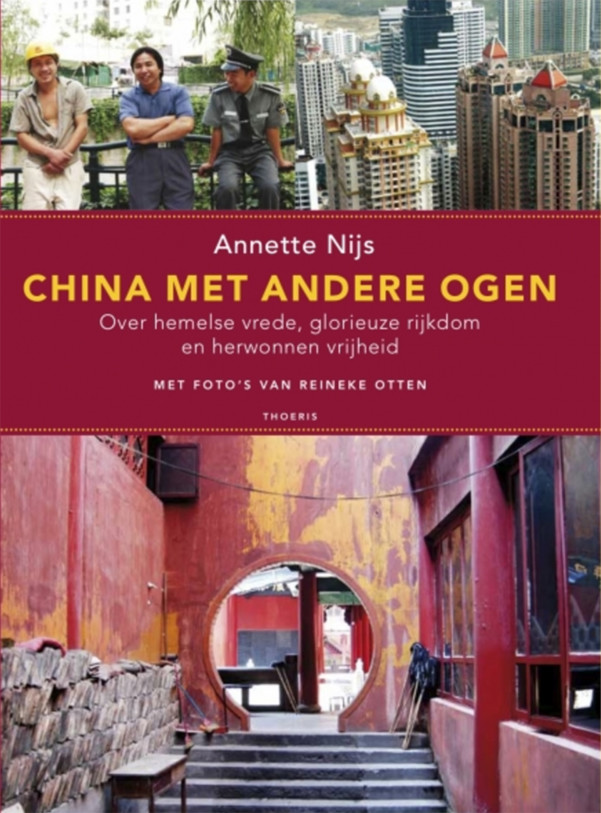China Through Different Eyes : A Book by Annette Nijs
Over the years I have read many books on China. It is my hobby, my area of expertise and how I make my living. But one book in particular has a special place in my heart: Annette Nijs’s China met andere ogen [Eng: China through different eyes]. Although already published in 2009, I still recommend this book to many of my customers and students. What makes it special is that the author offers an appealing, unique perspective: China as a role model for success and happiness. Also, the pictures in the book, made by ‘streetologist’ Reineke Otte, are real pieces of art that provide insights into daily Chinese life and illustrate the views of the author vividly.
In her book, Annette Nijs completely sets aside the more common discussions on human rights, corruption, freedom of speech, labour safety and environmental damage. In her work as executive director of the China Europe International Business School in China, as Vice-Minister for Education and her work for Shell, which have enabled her to travel to China frequently, she learnt a lot and she has read extensively about China, its people and its culture. In doing so, she has seen the downsides of China, but was more intrigued by the country’s many positive aspects. She does not shut her eyes to the negative issues, but it is not the main focus of her work. Instead, China met andere ogen sets out to demonstrate the positive aspects of Chinese culture, highlighting certain values and styles of government policy, conducting business and general life philosophy. She provides facts as well as details on systems and models of Chinese society, adding to our theoretical knowledge of China, and adding to our understanding of China. The book offers interesting insights, well-founded by examples and clarifications of many well-known experts, all of which might even be beneficial to Western society.
The book is divided into three parts. In the first part, the author discusses Chinese state government. She explains the benefits of bottom-up consultative democratic process, which is common practice in China. She describes how this form of governing ensures that the population participates actively in establishing policy. In addition, she clarifies that China’s leaders take good care of their people, which is largely due to the influences of Confucian principles. Finally, the efforts of central government to stimulate innovation are highlighted. Huge budgets are provided and certain policies are favoured to create an optimum atmosphere for innovation. In other words, participation, taking care of people and fostering creativity are important to Chinese state government, as reflected in its policies.
In the second part, the author discusses how Chinese business is conducted. She asserts that, in general, Chinese business follows the Chinese economy model based on the idea of “think nationwide, act local”. She argues that Chinese managers are holistic thinkers, so they take a wide and complex range of factors into account. This way, they are well equipped for any situation and can rely on a fundamental ‘Fingerspitzengefuhl’. She points out that Chinese companies are very keen on innovation and sustainable growth. At the same time, business in China is based on mutual trust, which truly stimulates successful cooperation. In this section, the author argues that Chinese people are very active and competitive entrepreneurs, and that strong central leadership is vital for the success of companies. At the same time, a safe, innovative environment based on mutual trust is just as essential.
The third and final part of the book focuses on the art of living. Annette Nijs starts by explaining how the sense of wanting to enjoy luxury really provides chances for Chinese markets. If people enjoy having and using luxury products and want to buy them, then the result is much higher demand, for which the companies, then, in turn need to provide. She goes on to describe the deep respect the Chinese have for their culture and that they are very proud of their legacy, one which is deeply rooted in the way people live and lead their lives. In particular, she points out the Chinese traditions of loyalty and social responsibility, old Confucian virtues. She also discusses the growing awareness the Chinese have for their surroundings, which is not only reflected in the environmental policies, but is also entrenched in the individual people’s daily lives. She finishes by arguing that, even though there is strict state censorship, the Chinese people’s creativity enables them to, nonetheless, get access to any information they want. In short, the Chinese art of living is based on Confucian virtues, environmental awareness and resourcefulness.

In conclusion, this book will inspire you. It provides a more balanced perspective on China, also highlighting some positive and inspiring aspects: the importance of social responsibility and mutual trust, environmental awareness, and the importance of creativity and innovation. We all know about the challenges China is facing, but it is worthwhile to learn more about these valuable assets Chinese culture has to offer.
By Lianne Baaij

 Share on Facebook
Share on Facebook Share on Twitter
Share on Twitter Share on LinkedIn
Share on LinkedIn